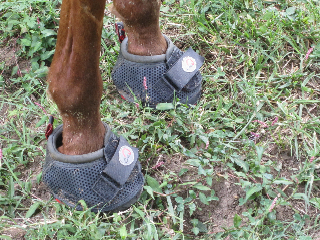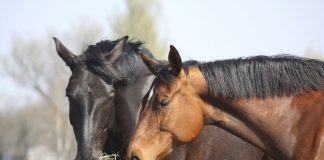
This year seemed much like the other 7 years I’d spent in Tennessee, until nearly all the horses I work with, including my own, were walking as though on a bed of nails. I noticed quickly that these stilted and sore gaits were accompanied by pounding pulses and stiffened crests, and knew I was dealing with an influx of laminitis. So, I hung up my riding boots and slipped on my gum shoes, determined to find the source of this affliction. What was causing these horses to have these symptoms? Some of these horses were on pasture, so you may jump to spring grass as the cause, but that’s only part of the answer. Even dry lots, muzzles, and stalls weren’t enough to combat this scourge. A 19 yr old pony confined to a stall and put on meds still had sore feet. A 5 year old Quarter Horse mare had her owner and me scratching our heads. With normal blood work, including a highly functioning thyroid, she was still sore while in a dry lot eating hay. My own 13 year old mare’s right front foot transformed from decent looking to dished and grooved overnight and her other three hooves followed within two weeks. There were others too – trips to my clients’ farms for lessons became laminitis interventions. It was downright depressing!
I immediately put her back on the “weight-gain” ration. It was playing a more significant role in maintaining her nutritional balance than I had realized. While this slowed her metabolic decline, it took regular tweaking and additional supplementation in her diet to halt the damaging effects, make her comfortable, and let the healing process begin.
“It’s the hot and humid weather we have in the South that makes the grass problematic for some horses,” says Dr. Marc Smith of Natchez Trace Veterinary Services in Franklin, Tennessee. “The grass in this area is predominately fescue and designed to put weight on livestock. It has a high sugar content and an endophyte to which some horses may react. In a horse this reaction is expressed in the feet. It’s like a kid at the fair eating sugary foods all day then getting sick that night.”
Grass, especially in the spring, is widely known to cause trouble, but I was shocked when horses that have no predisposing characteristics were still struggling with laminitis deep into summer. I found out that even a horse who primarily eats hay can still have a metabolic event.

“What’s in the grass is in the hay,” explains Dr. Smith. “Also, once a horse has been metabolically compromised, he’s likely to develop sensitivity and be reactive to any dietary change or imbalance.”
The reason is, says Smith, “When the bacteria in the gut are disturbed, they die and release toxins into the horse’s system and can cause laminitis.” This is in line with my experience. I modified my horses’ diets to combat the effects of the grass, correct nutritional imbalances, and keep their systems stabilized. “While there are some breeds and body types that can be more prone, any horse can be affected, Smith says. Genetics or lifestyle factors such as feed, management, and location can trigger this condition.”
I learned this year that no horse is immune to laminitis. It can strike at any minute of any day from nearly any dietary change or deficiency. Vigilance is key. I check each horse regularly looking for their “tell” that a metabolic event is coming on – a stiff or thickened crest, uneven or shortened gaits, or bounding digital pulse. At the first signs I make immediate changes to diet and/or management. I have become quite good at halting the process and minimizing the damaging effects. Maintaining my horse’s and my client’s horses’ equilibrium takes time and an array of specialized supplements and feed, but that’s what it takes to keep our horses healthy and happy. It’s a new normal – laminitis is on my radar like never before and won’t catch me or my horses off guard again.
Liked this article? Here are others you’ll love:
First Aid for Lamintiis
Ask the Vet: Laminitis Recovery Time
Ask the Vet: Preventing Laminitis
Thanks to Dr. Marc Smith of Natchez Trace Veterinary Services in Franklin, Tennessee for his assistance with this article.







thank you for this article it was informative and I have mare who is very prone to laminitis so much so her crest is severely abnormal while my other 2 always appear okay
cool
Over the years, I have been plagued with laminitis in my Arabians. I lost my horse at the age of 6. We fought it for 2 years but it finally took him. I discovered my well water was very acidic. Normally it should be 5.90 and mine was 2.85 tested several times. I only realized this at the very last as I was having major health problems as well. Hooked up to the county water & eliminated that problem. The second Arabian I lost, we fought it for four years, he did fine until last summer when he abscessed. It eventually lead to abscesses in both front hooves and then came the laminitis with a vengeance. The original cause for this horse to have foundered was acorns. It was discovered he was eating them off the lower end of the branches late in the summer. I called NC State Vet Med Dept. and they confirmed that the acorns would founder a horse quickly because of the amount of protein which is high in the green ones. I took precautions from then on and put electric fence around the trees and had the tree company come out and trim up the trees as well. Any pasture in the south has oak trees and why mine chose to eat them, I will never know. All I know is I have had really bad luck with these 2 and miss them dearly. I recused another Arabian last year that the county had seized because she was nearly starved to death. She is doing great but I take every precaution I can in order to prevent to ever hear this cuss word laminitis again! I hope what I have told will help someone in case they are at a loss on what is causing theirs….
Laminitis is so scary!
I would like to see a photo of what you mean by a thickened crest. I did not know to look for that symptom.